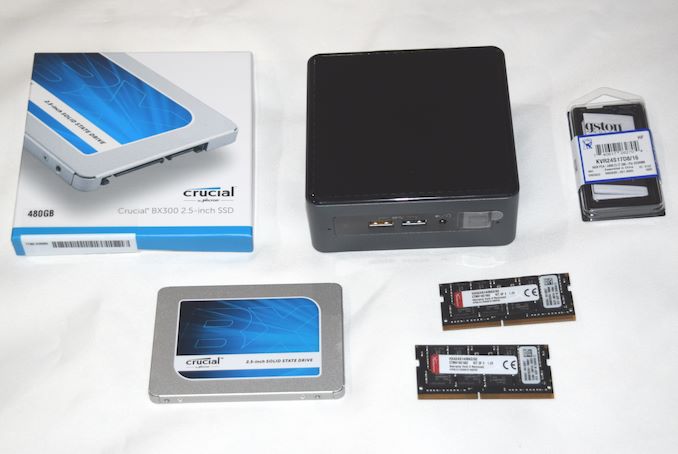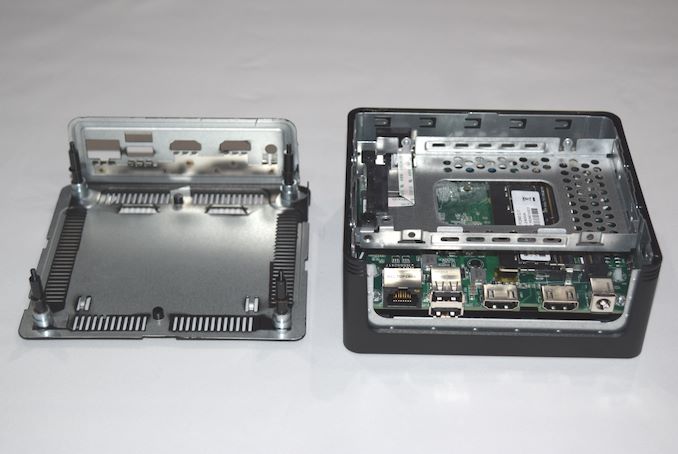Gemini Lake SFF PC Showdown: Intel's June Canyon (NUC7PJYH) and ECS's LIVA Z2 Reviewed
by Ganesh T S on December 20, 2018 8:00 AM ESTConcluding Remarks
Earlier I briefly touched upon the HTPC capabilities of the two Gemini Lake PCs. Of the two, the ECS LIVA Z2 is particularly attractive due to its passively cooled nature. Gemini Lake has one of the most power-efficient and full-featured video decoders in the market - It is capable of even handling VP9 Profile 2 in hardware. The only disappointing aspect from a HTPC viewpoint is that HDR is not supported. Consumers looking for a full-featured HTPC setup have to look beyond Gemini Lake for their needs. That said, if HDR is not a concern (as is likely in most TVs installed in a secondary location), Gemini Lake in general and the ECS LIVA Z2 in particular are good choices to consider.
Moving on to the power consumption aspect, we recorded the maximum sustained at-wall numbers while running the AIDA64 System Stability Test.

These numbers show that Gemini Lake, despite running at the same clocks as Apollo Lake, has managed to provide better performance per watt. The raw numbers are approximately the same when two systems with similar cooling situations are compared.
The Intel June Canyon NUC7PJYH Build Components
Coming to the business end of the review, Gemini Lake has shown itself to be a solid successor to Apollo Lake. Doubling the internal cache has led to significant performance increase in many real-life workloads. This is particularly evident when comparing the performance numbers of the NUC7PJYH (June Canyon) and the older NUC6CAYH (Arches Canyon). In addition to the performance bump, we also have better Wi-Fi capabilities. The product is not perfect, though - the installation of a 2.5" drive is not as easy as it is in some of the other UCFF PCs such as the ECS LIVA Z2. With the rise in popularity of M.2 SSDs, Intel could as well replace the 2.5" drive caddy with a M.2 SATA SSD-only slot on the motherboard, and reduce the system volume. The default fan curves could always use some tweaking, but, that is more of a subjective issue. These are very minor issues.
Accessing the Drive Caddy and the SODIMM Slots in the ECS LIVA Z2
On the other hand, the move from the ECS LIVA Z to the Z2 is a mixed bag. While the all-important fanless nature is still present, the retaining of aspects such as the measly 32GB of eMMC (with Windows 10 Home pre-installed) do not make for a good user experience. 32GB of eMMC may suffice for certain single-purpose industrial application systems, but, as a general-purpose PC, consumers will need to install an additional 2.5" SATA drive (similar to what we had to do for processing this review). Some consumers may appreciate the replacement of the mini-DP port in the LIVA Z with a full-sized HDMI one in the LIVA Z2. However, the sacrifice of a second LAN port for this is not a particularly good trade-off. That said, the performance increase enabled by Gemini Lake still makes the ECS LIVA Z2 a good choice over the ECS LIVA Z for most applications.












59 Comments
View All Comments
mode_13h - Friday, December 21, 2018 - link
I think the main reason for Intel doubling last-level cache vs. Apollo Lake is all the cheapo systems using this in single-channel mode.IntelUser2000 - Thursday, December 20, 2018 - link
"Doubling the internal cache has led to significant performance increase in many real-life workloads."Come on. It's not due to cache. Goldmont Plus cores in Gemini Lake has substantial architectural improvements. Doubled caches are usually responsible for maybe 5% increase in performance.
shelbystripes - Friday, December 21, 2018 - link
Ummm... that’s not really a valid assumption. Sure, if the system already has enough cache, adding more cache will not substantially increase performance.But the cache size is actually small enough to restrain performance (which can happen with these smaller, lower-cost parts). The “doubling” here is going from 2MB to 4MB L2 cache, which for the quad-core designs compared here, means effectively from 0.5MB per core to 1MB of L2 cache per core.
That sounds like a lot of L2 cache, until you realize there’s no L3 cache. That’s it, 0.5-1MB per core of last-level cache, and then you’re going to system RAM.
Is there even an Intel Core CPU made today with only 0.5MB of last level cache? Those tend to have only 256KB of L2, but then at least 1MB of L3 per core. That’s enough cache that adding more cache won’t help you much. Given the smaller, simpler design of Atom, I’m not surprised going up to 1MB of L2 cache per core would yield substantial performance benefits.
Brunnis - Friday, December 21, 2018 - link
Goldmont Plus has substantial architectual enhancements that are much more likely to account for the lion’s share of the performance increase. The article makes it seem Goldmont Plus is mainly about larger L2, which is a bit misleading. See this link:https://en.wikichip.org/wiki/intel/microarchitectu...
Brunnis - Friday, December 21, 2018 - link
Even smaller compute heavy benchmarks perform 20-30% faster, which is usually not the case for a mere L2 size increase (I’ve never seen that, at least).mode_13h - Friday, December 21, 2018 - link
The performance impact of cache is highly workload-dependent. However, it does sound like there are some significant improvements:https://en.wikichip.org/wiki/goldmont_plus#Key_cha...
Smell This - Thursday, December 20, 2018 - link
So ...How many tens of billions of dollars has Chipzilla spent subsidizing the 'Next Units' and Atom 'Fails'?
The 'new' NUCs are not, really, all that. An AMD Ryzen V1000 SoC mini-ITX FP5 BGA at 12/14nm would 'Temash' the Atom at 10-12w.
ZOLTAC ... make it so.
Death666Angel - Thursday, December 20, 2018 - link
I'd take some more AM4 mSTX motherboards. There are quite a few Intel ones, but the beefier iGPU for AMD would make for a more well rounded system.Alien88 - Saturday, December 22, 2018 - link
Check out the Udoo Bolt...LMonty - Friday, December 21, 2018 - link
Hello Ganesh, could you pls. confirm whether the NUC operates in dual channel mode when using 32GB of RAM? I saw one review on Amazon complaining that his J5005 NUC was running in single channel mode, when using 2x8GB sticks (16GB total).